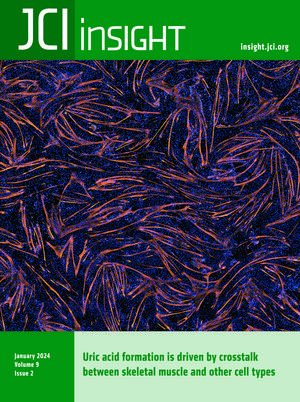细胞因子/趋化因子正反馈环路在 IgG4 相关疾病中建立了浆细胞树突状细胞驱动的自身免疫性胰腺炎。
IF 6.3
1区 医学
Q1 MEDICINE, RESEARCH & EXPERIMENTAL
引用次数: 0
摘要
通过服用多聚肌苷酸诱发的自身免疫性胰腺炎伴 IgG4 相关疾病(AIP/IgG4-RD)小鼠模型的发病机制尚不完全清楚。虽然已知小鼠和人类 AIP/IgG4-RD 是由产生 IFN-α 的浆细胞状树突状细胞(pDCs)驱动的,但这些细胞的来源及其与效应 T 细胞的关系尚不清楚。在这里,我们发现小鼠的 AIP 是由未发炎胰腺中携带 TLR3 的传统 DCs 启动的,TLR3 配体(聚肌苷酸)激活这些 DCs,导致 IFN-α、CXCL9 和 CXCL10 分泌。这反过来又诱导胰腺招募 CXCR3+ T 细胞,这些 T 细胞通过分泌 CCL25 促进携带 CCR9 的 pDC 向胰腺迁移。这就建立了一个反馈回路,由现在占主导地位的 pDC 产生 IFN-α,CXCR3+ T 细胞继续促进 pDC 迁移。值得注意的是,CXCR3+ T 细胞和 pDC 之间的相互作用也存在于功能层面,因为这种相互作用分别增强了 CXCR3+ T 细胞和 pDC 产生的 CCL25 和 IFN-α。本文提出的证据表明,人类AIP/IgG4-RD也存在类似的疾病机制,这为疾病治疗开辟了新的途径。本文章由计算机程序翻译,如有差异,请以英文原文为准。
A positive cytokine/chemokine feedback loop establishes plasmacytoid dendritic cell-driven autoimmune pancreatitis in IgG4-related disease.
The pathogenesis of the murine model of autoimmune pancreatitis associated with IgG4-related disease (AIP/IgG4-RD) induced by administration of polyinosinic-polycytidylic acid, is incompletely understood. While it is known that murine and human AIP/IgG4-RD is driven by plasmacytoid dendritic cells (pDCs) producing IFN-α, the origin of these cells and their relation to effector T cells is not known. Here we show that murine AIP was initiated by TLR3-bearing conventional DCs in the uninflamed pancreas whose activation by TLR3 ligand (polyinosinic-polycytidylic acid) caused IFN-α, CXCL9, and CXCL10 secretion. This, in turn, induced pancreatic recruitment of CXCR3+ T cells and these T cells, via their secretion of CCL25, facilitated migration of pDCs bearing CCR9 into the pancreas. This established a feedback loop anchored by the now dominant pDC production of IFN-α and the continued CXCR3+ T cell facilitation of pDC migration. Remarkably, the interaction between CXCR3+ T cells and pDCs also existed at the functional levels since this interaction enhanced the production of CCL25 and IFN-α by CXCR3+ T cells and pDCs, respectively. Evidence presented here that a similar disease mechanism was present in human AIP/IgG4-RD creates new avenues of disease treatment.
求助全文
通过发布文献求助,成功后即可免费获取论文全文。
去求助
来源期刊

JCI insight
Medicine-General Medicine
CiteScore
13.70
自引率
1.20%
发文量
543
审稿时长
6 weeks
期刊介绍:
JCI Insight is a Gold Open Access journal with a 2022 Impact Factor of 8.0. It publishes high-quality studies in various biomedical specialties, such as autoimmunity, gastroenterology, immunology, metabolism, nephrology, neuroscience, oncology, pulmonology, and vascular biology. The journal focuses on clinically relevant basic and translational research that contributes to the understanding of disease biology and treatment. JCI Insight is self-published by the American Society for Clinical Investigation (ASCI), a nonprofit honor organization of physician-scientists founded in 1908, and it helps fulfill the ASCI's mission to advance medical science through the publication of clinically relevant research reports.
 求助内容:
求助内容: 应助结果提醒方式:
应助结果提醒方式:


